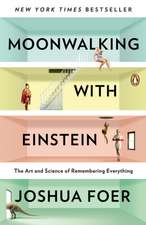Retrotransposition, Diversity and the Brain: Research and Perspectives in Neurosciences
Editat de Fred H. Gageen Limba Engleză Hardback – 5 dec 2007
| Toate formatele și edițiile | Preț | Express |
|---|---|---|
| Paperback (1) | 706.97 lei 6-8 săpt. | |
| Springer Berlin, Heidelberg – 18 noi 2010 | 706.97 lei 6-8 săpt. | |
| Hardback (1) | 711.72 lei 6-8 săpt. | |
| Springer Berlin, Heidelberg – 5 dec 2007 | 711.72 lei 6-8 săpt. |
Din seria Research and Perspectives in Neurosciences
- 18%
 Preț: 944.99 lei
Preț: 944.99 lei - 18%
 Preț: 938.83 lei
Preț: 938.83 lei - 18%
 Preț: 941.68 lei
Preț: 941.68 lei - 18%
 Preț: 1218.21 lei
Preț: 1218.21 lei - 18%
 Preț: 945.92 lei
Preț: 945.92 lei - 5%
 Preț: 1403.44 lei
Preț: 1403.44 lei - 18%
 Preț: 1215.70 lei
Preț: 1215.70 lei - 18%
 Preț: 944.36 lei
Preț: 944.36 lei - 18%
 Preț: 936.95 lei
Preț: 936.95 lei - 18%
 Preț: 944.19 lei
Preț: 944.19 lei - 15%
 Preț: 638.89 lei
Preț: 638.89 lei - 18%
 Preț: 945.62 lei
Preț: 945.62 lei - 15%
 Preț: 636.63 lei
Preț: 636.63 lei - 15%
 Preț: 636.63 lei
Preț: 636.63 lei - 18%
 Preț: 886.62 lei
Preț: 886.62 lei - 15%
 Preț: 635.47 lei
Preț: 635.47 lei - 15%
 Preț: 636.30 lei
Preț: 636.30 lei - 15%
 Preț: 635.65 lei
Preț: 635.65 lei - 15%
 Preț: 636.12 lei
Preț: 636.12 lei - 24%
 Preț: 734.67 lei
Preț: 734.67 lei -
 Preț: 422.31 lei
Preț: 422.31 lei - 5%
 Preț: 517.17 lei
Preț: 517.17 lei - 18%
 Preț: 937.41 lei
Preț: 937.41 lei
Preț: 711.72 lei
Preț vechi: 749.19 lei
-5% Nou
Puncte Express: 1068
Preț estimativ în valută:
136.18€ • 142.57$ • 112.69£
136.18€ • 142.57$ • 112.69£
Carte tipărită la comandă
Livrare economică 05-19 aprilie
Preluare comenzi: 021 569.72.76
Specificații
ISBN-13: 9783540749653
ISBN-10: 3540749659
Pagini: 135
Ilustrații: XII, 123 p.
Dimensiuni: 155 x 235 x 12 mm
Greutate: 0.32 kg
Ediția:2008
Editura: Springer Berlin, Heidelberg
Colecția Springer
Seria Research and Perspectives in Neurosciences
Locul publicării:Berlin, Heidelberg, Germany
ISBN-10: 3540749659
Pagini: 135
Ilustrații: XII, 123 p.
Dimensiuni: 155 x 235 x 12 mm
Greutate: 0.32 kg
Ediția:2008
Editura: Springer Berlin, Heidelberg
Colecția Springer
Seria Research and Perspectives in Neurosciences
Locul publicării:Berlin, Heidelberg, Germany
Public țintă
ResearchCuprins
Telomeres and Telomerase in Human Health and Disease.- Molecular and Circuit Mechanisms for Hippocampal Learning.- Retrotransposons – Natural and Synthetic.- Ancient Retrotransposons as Possible Remnants of the Primitive RNPWorld.- Human Diversity and L1 Retrotransposon Biology: Creation of New Genes and Individual Variation in Retrotransposition Potential.- From the “RNAWorld” to Brain Complexity: Generation of Diversity.- Endogenous Retroviruses and Human Neuropsychiatric Disorders.- Is Psychosis Due to Retroviral/Retrotransposon Integration Close to the Cerebral Dominance Gene?.- Microcephalies and DNA Repair.
Textul de pe ultima copertă
Retroelements are ancient mobile DNA found in most organisms. Long dismissed as useless, selfish or "junk" DNA, they were thought to be mere intracellular parasites from our distant evolutionary past. Together with their mutant relatives, L1 sequences constitute almost 50% of the mammalian genome. L1s can retrotranspose in a defined window of the neuronal differentiation, changing the genetic information in single neurons in a "random" fashion, allowing the brain to develop in distinct different ways. Such strategy contributes to expand the number of functionally distinct neurons that could be produced from a given stem cell gene pool. This characteristic of variety and flexibility may contribute to the uniqueness of an individual brain, even between genetically identical twins. These mobile elements may be part of conserved core process responsible for evoking facilitated complex non-random phenotypical variation on which selection may act. A detailed understanding of the basic mechanisms of L1 activity may shed light on one possible mechanism for generating neural diversity.
The book results from a fascinating and stimulating exchange of ideas at the interface of the complexity of brain organization and function, the mechanisms for generating diversity and genetic mobility. This meeting of leading geneticists, molecular biologists and neuroscientists was organized by the Fondation IPSEN. Its ambitious goal was to expand the current limits of research in neurobiology not only to the benefit of those interested in the cellular and molecular processes but also for the understanding of high-level cognitive functions and the understanding of complex mental diseases. The reader can judge how far the book achieves this.
The book results from a fascinating and stimulating exchange of ideas at the interface of the complexity of brain organization and function, the mechanisms for generating diversity and genetic mobility. This meeting of leading geneticists, molecular biologists and neuroscientists was organized by the Fondation IPSEN. Its ambitious goal was to expand the current limits of research in neurobiology not only to the benefit of those interested in the cellular and molecular processes but also for the understanding of high-level cognitive functions and the understanding of complex mental diseases. The reader can judge how far the book achieves this.
Caracteristici
Includes supplementary material: sn.pub/extras













